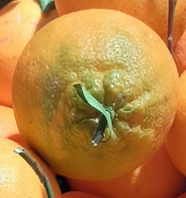Check the ingredients!
... live healthy!


| "Descrizione" by A_Partyns (12876 pt) | 2024-Aug-30 18:41 |
| Evaluation | N. Experts | Evaluation | N. Experts |
|---|---|---|---|
| 1 | 6 | ||
| 2 | 7 | ||
| 3 | 8 | ||
| 4 | 9 | ||
| 5 | 10 |
Orange (Citrus aurantium dulcis) seems to have originated in China and was brought to the Mediterranean by Italian navigators around 1450. The tree belongs to the Rutaceae family and the fruit is used industrially by food, cosmetic and pharmaceutical companies. It contains numerous components of interest to human health such as flavonoids, terpenes, linalool, vitamin C, folic acid, with antioxidant properties.

Citrus aurantium dulcis, commonly known as the sweet orange, is a widely cultivated fruit tree renowned for its juicy, sweet-tasting citrus fruit. Native to Southeast Asia, it is now grown in tropical and subtropical regions around the world. The sweet orange is a major commercial crop and is used in a variety of culinary, medicinal, and cosmetic applications.
Botanical Classification:
Plant Characteristics:
Chemical Composition and Structure:
How to Cultivate It:
Uses and Benefits:
Applications:
Environmental and Safety Considerations:
Studies
An orange contains on average:
Almost everything is used in the plant:
In the medical field used against:
From the orange peel we obtain an essential oil that is interesting for health, the Citrus aurantium dulcis peel oil.
Citrus aurantium dulcis peel oil is an oil obtained with a chemical process from the orange peel, it is a sesquiterpene with antioxidant properties.
It is used as aroma in food, beverages, in cosmetics and in body cleansers with a function:
Extraction and antioxidant activity
The current method used in most countries for the production of cold-pressed orange oil is the simultaneous extraction of an emulsion of juice and oil from the whole fruit. Cold pressed orange oil contains waxes, pesticide residues and carotenoids (1). The current method used in most countries for manufacturing cold-pressed orange oil is simultaneous extraction of a juice and oil emulsion from the whole fruit. Cold-Pressed orange oil contains waxes, pesticide residues and carotenoids. For this reason it would be appropriate to adopt a molecular distillation method to remove them as this oil can be used in the clinical treatment of patients with malignant brain tumors (2), to inhibit angiogenesis, metastasis and cell death in human colon cancer cells (3).
In this study, the orange peel of 12 cultivars of Citrus sinensis from central-eastern Sicily was employed to obtain essential oils and extracts. The ones were extracted through steam distillation, the others through extraction in hexane. Chemical constituents were evaluated in terms of qualitative and quantitative analyses by gas chromatography/mass spectrometry. Fifty-four components were identified in the steam essential oils and 44 in the extracts. In all the cultivars, the main component is d-limonene (73.9-97%); discrete percentages of linalool, geraniol and nerol were also found. Cluster analysis based on essential oils composition showed a certain degree of affinity between cultivars of the same type. The antimicrobial activity was investigated against three micro-organisms (Staphylococcus aureus, Listeria monocytogens and Pseudomonas aeruginosa). 'Sanguinello' and 'Solarino Moro' essential oils are significantly active against L. monocytogenes, while 'Valencia' hexanic extract against all the tested micro-organisms(4).
Acute otitis media (AOM) animal model was built and diet containing orange peel essential oil microcapsules were administrated to AOM animals. Pharmacological test showed that orange peel essential oil treatment could decrease serum and cochlea malondialdehyde (MDA), immunoglobulins A (IgA), immunoglobulins G (IgG), immunoglobulins M (IgM) levels and increase antioxidant enzymes activities. It can be concluded that orange peel essential oil treatment could decrease oxidative injury in acute otitis media rats.
Typical chemical composition of an orange essential oil
Twenty four compounds, accounting for 97.9% of the total oil, were identified based on their mass spectra. The main components were terpenic molecules, and the oil was composed of 97.3% monoterpenes (which include 19.0% oxygenated monoterpenes) and 0.5% sesquiterpenes. The main constituents were limonene (74.6%), limonene 1,2-epoxide (3.5%), cis-p-mentha-2,8-dien-1-ol (3.2%) and (E)-carveol (2.4%) (6).
Molecular formula: C15H24O
CAS: 8008-57-9
References________________________________________________________________________
(1) Antioxidant and Anticancer Activities of Essential Oil from Gannan Navel Orange Peel. Yang C, Chen H, Chen H, Zhong B, Luo X, Chun J. Molecules. 2017 Aug 22;22(8). pii: E1391. doi: 10.3390/molecules22081391.
(2) Preclinical development and clinical use of perillyl alcohol for chemoprevention and cancer therapy. Chen TC, Fonseca CO, Schönthal AH Am J Cancer Res. 2015; 5(5):1580-93.
(3) D-limonene rich volatile oil from blood oranges inhibits angiogenesis, metastasis and cell death in human colon cancer cells. Chidambara Murthy KN, Jayaprakasha GK, Patil BS Life Sci. 2012 Oct 5; 91(11-12):429-439.
(4) Essential oil components of orange peels and antimicrobial activity. Geraci A, Di Stefano V, Di Martino E, Schillaci D, Schicchi R. Nat Prod Res. 2017 Mar;31(6):653-659. doi: 10.1080/14786419.2016.1219860. Epub 2016 Aug 18.
(5) Effect of orange peel essential oil on oxidative stress in AOM animals. Lv YX, Zhao SP, Zhang JY, Zhang H, Xie ZH, Cai GM, Jiang WH. Int J Biol Macromol. 2012 May 1;50(4):1144-50. doi: 10.1016/j.ijbiomac.2012.02.002. Epub 2012 Feb 10.
(6) Antioxidant and Anticancer Activities of Essential Oil from Gannan Navel Orange Peel. Yang C, Chen H, Chen H, Zhong B, Luo X, Chun J. Molecules. 2017 Aug 22;22(8). pii: E1391. doi: 10.3390/molecules22081391.
| Evaluate |